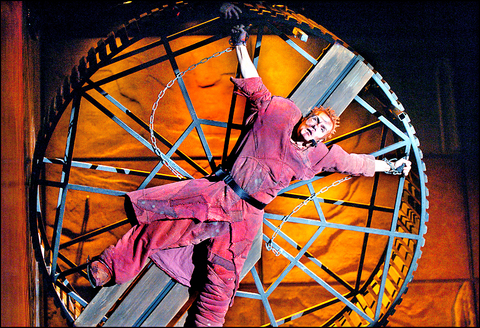Given the huge success of Victor Hugo's Les Miserables as a musical, it was only a matter of time before the French novelist's 1831 tale of love and betrayal, Notre Dame de Paris, hit the stage. Hollywood produced a film version in the 1930s, and Disney created an animation; but not until the mid-1990s did the tragedy become a major French language musical. Now on its first Asian tour the production will run for 10 days at the Sun Yat-sen Memorial Hall in Taipei.
French-Canadian Lu Plamondon made a name for himself as a lyricist writing songs for Celine Dion before he started composing rock operas in the seventies. After his box office hit Starmania in 1979, he combined his talent for writing lyrics with Italian composer Richard Cocciante's talent for writing music. The two worked on the Notre Dame project for three years before joining forces with dance theater director Gilles Maheu.
Notre Dame de Paris was first staged in France in 1998 and with a cast of European and Canadian musicians it achieved record-high ticket sales in its first year of production. Equally popular is the DVD and album version starring musicians Daniel Lavoie and Bruno Pelletier. An English translation of the show with guest appearance by Celine Dion was performed in the UK and the US but never reached the same level of success as its French predecessor.

PHOTO COURTESY OF NEW ASPECT
The cast has evolved since its first staging seven years ago but still boasts a number of established actors and musicians. French songstress Nadia Bel stars in the lead role as Esmeralda alongside Canadian vocalist Matt Laurest as Quasimodo.
More than 50 songs are included in the repertoire producing a show almost entirely told through song and dance with a few interpolations of dialogue. The choreography blends classical, street and acrobatic styles and complements the costume design, which also combines period pieces with modern-day themes. Set in 15th-century Paris the legendary Notre Dame cathedral is a fitting backdrop to the story.
Remaining true to Hugo's novel, Plamondon does not conceal its tragic outcome behind a happy ending. The show's narrator, Gringoire, sets the mood by opening with a song about changing values and emerging public unrest in the city. Exploring themes of love and prejudice, the story focuses on the ill-fated Esmeralda, a beautiful gypsy dancer from Spain and the deformed bell-ringer Quasimodo.
Phoebus, captain of the king's cavalry, is set to wed Fleur De Lys, but when his eyes fall upon the Spanish dancer his heart becomes torn between the captivating woman and his duty to Fleur De Lys and his country.
A callous priest Frollo and the naive hunchback Quasimodo are also in love with the young woman. The priest, unable to have her for himself, becomes consumed by jealousy. Accused of a crime she did not commit, Esmeralda is thrown in jail. Murder and betrayal ensue as the story reaches its climax and heartrending conclusion.

The canonical shot of an East Asian city is a night skyline studded with towering apartment and office buildings, bright with neon and plastic signage, a landscape of energy and modernity. Another classic image is the same city seen from above, in which identical apartment towers march across the city, spilling out over nearby geography, like stylized soldiers colonizing new territory in a board game. Densely populated dynamic conurbations of money, technological innovation and convenience, it is hard to see the cities of East Asia as what they truly are: necropolises. Why is this? The East Asian development model, with

June 16 to June 22 The following flyer appeared on the streets of Hsinchu on June 12, 1895: “Taipei has already fallen to the Japanese barbarians, who have brought great misery to our land and people. We heard that the Japanese occupiers will tax our gardens, our houses, our bodies, and even our chickens, dogs, cows and pigs. They wear their hair wild, carve their teeth, tattoo their foreheads, wear strange clothes and speak a strange language. How can we be ruled by such people?” Posted by civilian militia leader Wu Tang-hsing (吳湯興), it was a call to arms to retake

This is a deeply unsettling period in Taiwan. Uncertainties are everywhere while everyone waits for a small army of other shoes to drop on nearly every front. During challenging times, interesting political changes can happen, yet all three major political parties are beset with scandals, strife and self-inflicted wounds. As the ruling party, the Democratic Progressive Party (DPP) is held accountable for not only the challenges to the party, but also the nation. Taiwan is geopolitically and economically under threat. Domestically, the administration is under siege by the opposition-controlled legislature and growing discontent with what opponents characterize as arrogant, autocratic

Desperate dads meet in car parks to exchange packets; exhausted parents slip it into their kids’ drinks; families wait months for prescriptions buy it “off label.” But is it worth the risk? “The first time I gave him a gummy, I thought, ‘Oh my God, have I killed him?’ He just passed out in front of the TV. That never happens.” Jen remembers giving her son, David, six, melatonin to help him sleep. She got them from a friend, a pediatrician who gave them to her own child. “It was sort of hilarious. She had half a tub of gummies,